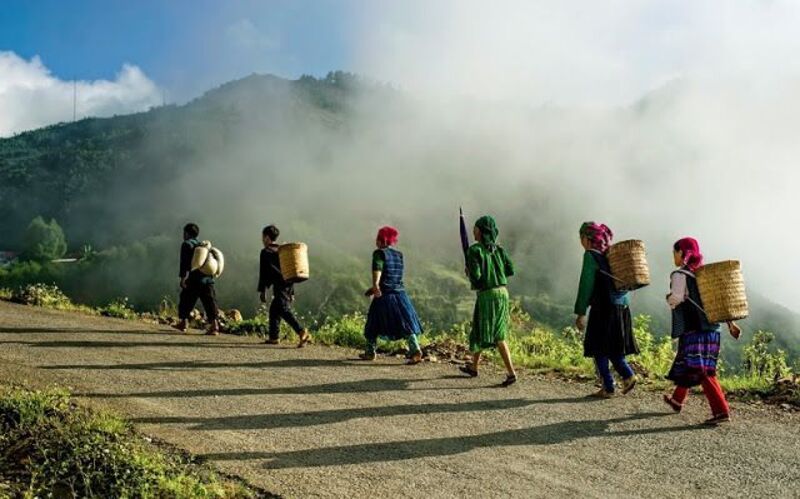Nestled in the northernmost region of Vietnam, Ha Giang is a mountainous province brimming with natural beauty and cultural richness. It’s a place where towering limestone peaks pierce the sky, cascading rice terraces paint the hillsides in emerald green, and vibrant ethnic minority cultures thrive. The Ha Giang Loop, a legendary motorbike route that winds through the region’s captivating landscapes, has become a bucket-list item for adventurous travelers. And to fully appreciate the majesty of this journey, understanding the secret of Ha Giang weather is key. And to fully explore Ha Giang, you need to learn details about Ha Giang weather. In the article below, Ha Giang Motorbikr Tours will provide you with useful information.
Ha Giang Loop – attractive tourist destination
Ha Giang is known for its breathtaking landscapes, rich indigenous culture, and adventure activities such as trekking and motorbike tours. The Ha Giang Loop, also known as the Dong Van Karst Plateau Geopark, is a 300-kilometer loop that takes you through some of the most stunning scenery in the region. The route begins and ends in the provincial capital of Ha Giang city and takes you through remote villages, past waterfalls, and along winding roads with jaw-dropping views.
The Ha Giang Loop has gained popularity among travelers seeking an off-the-beaten-path experience, as it offers an authentic glimpse into the daily lives of ethnic minority communities. You can stay in homestays along the way, taste traditional meals, and interact with locals to learn about their customs and traditions. But to fully enjoy this unique journey, understanding the different seasons and their impact on Ha Giang weather is essential.

The importance of understanding the weather in Ha Giang
Understanding the weather in Ha Giang plays an extremely important role in planning your trip. Thanks to understanding weather information, visitors can choose appropriate clothing, safe means of transportation and plan reasonable sightseeing activities.
Ha Giang has a diverse climate that changes with the seasons. Grasping the specific weather conditions of each season helps tourists be proactive in choosing the right time for their trip.
Furthermore, monitoring weather forecasts also helps tourists prepare all necessary items for the trip, ensuring safety against warnings of bad weather such as floods, landslides,…
Therefore, before setting out to explore Ha Giang, visitors should take the time to carefully learn about the weather here to have the safest, most fun and complete trip.

Overview of Ha Giang weather
Ha Giang has a temperate monsoon climate, with clear differentiation according to terrain, creating a diverse and impressive weather picture. This place has two main climate zones: the high mountains with a temperate, cool climate and the hotter valley region.
The general characteristics of Ha Giang’s weather are that the average annual temperature ranges from 18°C to 24°C, the temperature amplitude between day and night is large, hot summers, cold winters. Average annual rainfall ranges from 1000mm to 2400mm, focusing mainly on the rainy season lasting from May to October. Average annual humidity ranges from 70% to 80%, highest in the rainy season and lowest in the fall. dried.
Besides the common characteristics, Ha Giang’s weather is also strongly influenced by the terrain. High mountains block hot, humid air from the sea, bringing a cool climate. Rivers and streams absorb moisture, regulate the climate, reduce heat in summer and increase humidity in winter. The valley concentrates a lot of sunlight, creating a warmer atmosphere than the surrounding area.

Details Ha Giang weather by month
Thanks to the impact of the terrain, Ha Giang possesses four distinct seasons, each season has its own beauty: Spring is filled with peach and apricot blossoms; Brilliant summer with unique festivals; Mild autumn, ideal for trekking and climbing; Romantic winter with buckwheat flower hills in full bloom.
Exploring the weather in Ha Giang not only helps visitors plan their trip in detail but also brings interesting experiences when immersing themselves in the diverse and virtual nature here. Let’s plan your Ha Giang Loop Tour trip with Meditours Ha Giang in detail!
Ha Giang weather February-April
Ha Giang weather february – april (sping) is a time of resurgence and renewal. After the winter’s chill, the landscape awakens with vibrant life. The mountains are covered with blooming flowers, and the rice terraces turn a brilliant shade of green. This is considered the best time to trek or motorbike through the region as the temperatures are mild, and the scenery is at its most beautiful.
Temperature: The temperature begins to rise, ranging from comfortable highs in the mid-20s Celsius (mid-70s Fahrenheit) to cooler lows in the teens Celsius (mid-50s Fahrenheit). However, keep in mind that temperatures can vary greatly depending on your altitude, so make sure to pack layers accordingly.
Precipitation: As spring marks the end of the dry season, rainfall is relatively low during this time. You can expect occasional showers, but they are usually short-lived and will not disrupt your activities.
Best activities: Spring is an excellent time for trekking and motorbike tours as the weather is pleasant and the landscapes are lush and vibrant. It’s also a great time to explore the cultural side of Ha Giang, as many festivals and events take place during this season.
Things to note: The Tet holiday, Vietnam’s biggest festival, takes place during the spring months. This may affect travel plans and availability of accommodations, so it’s essential to plan accordingly.
See more: Best Time to Visit Ha Giang Weather & Traveling Tips

Ha Giang weather May-July
Summer in Ha Giang is characterized by hot and humid weather, with occasional heavy rainfalls. This is considered the low season due to the challenging weather conditions, but it can also be a great time to visit for those looking for a unique experience.
Temperature: The summer months in Ha Giang can be scorching, with temperatures reaching highs of 35 degrees Celsius (95 degrees Fahrenheit). The nights are slightly cooler, but it can still be uncomfortable and sticky.
Precipitation: The southwest monsoon brings heavy rains to the region during the summer months. Expect frequent showers that can sometimes last for hours, making travel on the roads more difficult.
Best activities: Despite the challenging weather, summer is an excellent time for adventure activities such as swimming in waterfalls and rafting in rivers. The lush greenery and blooming flowers make for stunning views, and the wet weather adds to the dramatic landscape.
Things to note: The rainfall can lead to landslides and road closures, so some areas of the Ha Giang Loop may not be accessible. It’s essential to check conditions before setting out on your journey.
Ha Giang weather August-October
Fall in Ha Giang is known as the harvest season, and the rice terraces turn golden, creating a breathtaking sight. The weather begins to cool down, making it an ideal time for outdoor activities. The landscapes are at their most picturesque, making fall a favorite among photographers.
Temperature: The temperature begins to drop during the fall months, with highs averaging around 25 degrees Celsius (77 degrees Fahrenheit) and lows in the teens Celsius (mid-50s Fahrenheit).
Precipitation: The rainfall decreases during fall, making it a great time to explore the region without worrying about unexpected downpours.
Best activities: Fall is a great time for trekking and motorbike tours, with comfortable temperatures and stunning scenery. You can also participate in the local rice harvesting activities and learn about the traditional methods of agriculture.
Things to note: As fall marks the end of the peak season, it’s a great time to visit if you prefer fewer crowds and lower prices. However, some popular accommodations may be booked in advance, so it’s essential to plan ahead.

Ha Giang weather November-January
Ha Giang weather November – January (winter) is considered the dry and cold season, with temperatures dropping significantly. But that doesn’t mean there isn’t anything to see or do. The landscape takes on a new look as the trees shed their leaves, revealing the stunning limestone formations that make this region so unique.
Temperature: The temperature during winter can drop to single digits Celsius (mid-40s Fahrenheit), especially at higher altitudes. Make sure to pack warm clothing if you’re traveling during these months.
Precipitation: Winter sees very little rainfall, making it an ideal time for outdoor activities. The skies are usually clear, allowing for beautiful views of the mountains and valleys.
Best activities: Winter is an excellent time for trekking and mountain biking, as the lower temperatures make it easier to navigate the rugged terrain. You can also visit local markets, festivals, and events to experience the cultural side of Ha Giang.
Things to note: Some areas along the Ha Giang Loop may become inaccessible due to snow, so it’s essential to check conditions before setting out on your journey.
Note when traveling to Ha Giang seasonally
As you can see, each season in Ha Giang has its own unique charm, and the weather plays a significant role in shaping your experience. Depending on your preferences and interests, you can plan your trip to Ha Giang accordingly. If you’re seeking an adventure through lush landscapes and vibrant cultures, spring or fall would be the best time to visit. For those looking for a unique experience in challenging weather, summer could be the perfect time to explore the region. And for those who want to see a different side of Ha Giang, winter offers a peaceful and tranquil atmosphere.
No matter which season you choose to visit, make sure to check the weather conditions and plan your activities accordingly. It’s also essential to have appropriate gear and clothing to stay comfortable and safe throughout your journey.

Conclusion
Ha Giang is a destination that never fails to mesmerize travelers with its natural beauty and rich cultural heritage. The region’s diverse Ha Giang weather patterns add to its charm, offering unique experiences throughout the year. Whether you’re seeking a thrilling adventure or a peaceful escape, understanding the secret of Ha Giang weather will ensure a memorable and enjoyable trip. So pack your bags, hop on your motorbike, and embark on the legendary Ha Giang Loop for an unforgettable journey through one of Vietnam’s most enchanting regions.


